Understand the GROW Model for Coaching

When researching coaching models, you have a lot from which to choose including the GROW model for coaching. As a team leader, you want to ensure everyone on your team is getting the best possible training and coaching. It will help them to learn new skills, solve problems, and become better at their jobs.

What Is the GROW Coaching Model?
The GROW model is essentially a framework that features all of the most important elements that are required for coaching to be effective. The structure is relatively simple and easy enough to follow. It comes from the 1992 book Coaching for Performance by John Whitmore, although it has been used by some business coaches earlier. It features four steps: Goal, Reality, Options, and Will Do (or Way Forward). GROW coaching has become the foundation for coaching in today’s business world.
In some cases, there could be an extra “T” added to the acronym, but it’s not always used. The T refers to Topic, and sometimes, it’s a good idea to have a topic in mind when going into a coaching session. It’s not always necessary, though. We’ll talk more about each of the elements below.
Understanding the Steps of the GROW Model for Coaching
Below, we’ll be looking into the various parts of this coaching model, so you can have a better understanding of how it works in practice. As you will see, it’s based on a common sense approach to coaching.
Setting Up a Goal
First, you have to determine what your session goal will be. When you have a goal in place, it helps to provide some added focus for the session. Be clear on what you want to achieve in each session and then come back to that goal in case things start to get off the rails. This can be helpful for those who are coaching people who may be easily distracted or who go off on tangents during the coaching sessions.
There are some telltale signs that will make you aware that you didn’t set up a session goal properly. For example, the session might end up going in circles and not getting anywhere. You might also run out of time without ever getting to the crux of the issue that needs to be addressed.
It is helpful to agree to the goal upfront. However, this is not always possible, and the goals might evolve and change somewhat during the course of training. Typically, it is a good idea to have just one goal for each session. Otherwise, it has the potential to muddy the training.
Therefore, you should always make it a point to create a goal for each of the sessions. You will also find that it tends to be easier to mark progress when you have goals you are trying to reach. It’s also important to understand that the goal and the topic are different. We will discuss topics more below.
The Current Reality
Next comes the R. During this portion of the session, coaches help their clients to better understand their current situation, or reality, and how they got there in the first place. What have they done thus far that is working for them? What have they done that is not working? It is about what’s happening now and what may need to be changed in the current reality to ensure the goals are achievable.
It is important, to be honest about the situation’s reality and to explore what may need to be changed, updated, and improved. Having a full assessment of where they are, what they could leverage, issues they might face, etc., will make the other steps a bit easier.
One of the other things to keep in mind is that the current reality has the potential to change. What is true right now might not be in a month or a year. Because the current reality can be fluid, you will want to make sure you are keeping up to date with the changes, so you can choose the right options and tasks.
What Are the Options?
After looking into the current reality of the situation, it’s time to start looking at some of the potential options available. Brainstorming can help trainers and learners to come up with a wide range of ideas that might be suitable based on the goal and the reality already discussed. Sometimes, it might be something as simple as making a small change to an action that already exists. It might mean needing to take a bigger action and potentially a larger risk. Other times, it might even mean shrinking an action to ensure it is achievable.
When discussing options, it’s important to keep the goal in mind, but you will also want to think outside the box. During the brainstorming stage, there aren’t any bad ideas. you can winnow out the good from the bad later. Think big, narrow the selection, and find the options that will best fit your needs. Working with a coach will make all of this much easier. Coaches can help their students to learn more about the available options, so they can find the ones that are best suited for them.
Will Do (or the Way Forward)
Coaching is about making a change and moving forward. This is what makes the Will Do portion of GROW so important. As mentioned earlier, this is sometimes called the Way Forward. It simply refers to what the learner will do once they leave their session. There should always be at least one action to take after the training session has been completed. Following through is what helps people to make true, lasting changes that make the coaching effective.
The actions, of course, will differ from one session to another. You will want to choose actions that should be taken, commit to those actions, deal with obstacles, and be accountable for completing those actions.
And Occasionally T
Topics are not essential, but they can be nice. If you have a basic overarching topic that you’ll be covering, it will often be easier to come up with a good goal for the session. Typically, trainers are going to use topics whenever they feel that the client/learner isn’t sure what needs to be worked on. Having a broad topic can often make it easier to then break down the different session goals. If you have trouble coming up with a goal right away, start with a broad topic and then narrow the focus.
Why Use the GROW Coaching Model?
Why are so many using this method of coaching? Because it works. It is a results-oriented type of coaching that allows the client to choose the actions they take. The system also tends to be easy to remember and follow. Once you understand the basic elements and start incorporating them into training, you can create quality, beneficial coaching sessions. As you come to know the GROW model even better, you will find that it becomes easier for coaches and trainees to stay focused during training sessions.
Training Requires Commitment from All Involved
When it comes to training, you can’t simply go through a session and hope that the information sticks. Trainer and learner both need to commit to taking those aforementioned actions to reach whatever goals were discussed. The GROW training method can work very well, but it does take buy-in and commitment from all of those who are involved.
How to Get More from GROW Coaching
Naturally, you want to get as much as possible from using the GROW model for coaching. Let’s look at a few of the practices you will want to adopt to make the training as smooth and beneficial as can be.
First, make sure that you are asking for buy-in from those who are being coached. Let them know more about the process and how it works, how to pick goals, etc. By getting the learners involved, they have more ownership over the coaching and are more likely to give more effort during the training sessions.
Additionally, you will want to familiarize yourself with SMART criteria when coming up with goals and plans. SMART is another acronym that stands for Specific, Measurable, Attainable, Relevant, and Time-Bound. While not all of your goals need to be SMART goals, it can be helpful to create SMART goals in some cases.
One of the other ways to ensure you are getting as much as possible from GROW coaching is to be prepared to change. Sometimes, those being coached start to see their goals differently and may need to change tactics to ensure they reach their new goals.
Although GROW might be simple to understand and implement as a training method, you will find that it’s more than just easy to remember—it really does work. The user-friendly system can provide a nice framework for determining goals and creating plans to attain them.
Of course, you will also want to revisit the plan to make changes as they become necessary.